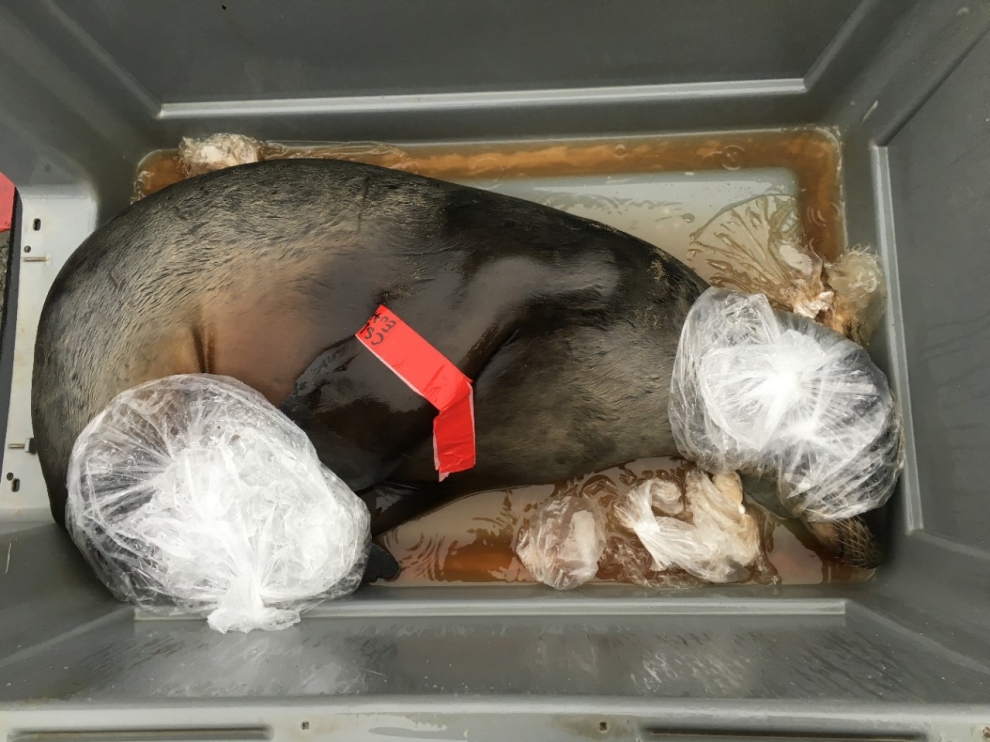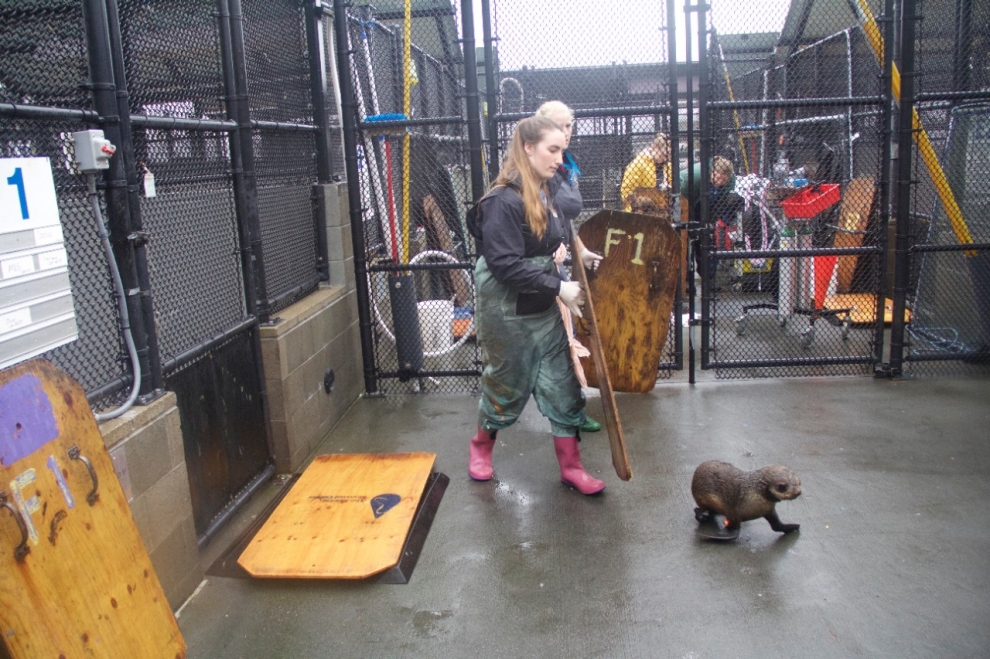
In warming ocean, record number of seals and sea lions sicken and starve
Azure Gilman
Jan. 8, 2016
SAUSALITO, Calif. _ They are brought in with all sorts of problems: lockjaw, poisoning, cancer and even bullet wounds from fishermen. But most of the record number of seals and sea lions washing up on California's shores and being brought to a regional rescue center are starving.
Unprecedented warm waters off the Pacific coast over the past two years have led fish that marine mammals feed on to move to colder waters — making it difficult for seals and sea lions to nourish themselves, let alone feed their pups. With the current El Niño weather event expected to continue bringing warm water over the rest of the winter, this slow-motion catastrophe is likely to continue.
Eating themselves from inside

The Marine Mammal Center in Sausalito, just outside San Francisco, rescues 600 to 800 seals and sea lions a year on average from the 600 miles of California coastline it covers, from north of San Francisco to just above Santa Barbara County in the south.
But in 2015, the center was brought a record 1,799 animals — including California sea lions, Guadalupe fur seals and northern fur seals. The 106 northern fur seals it rescued more than tripled its previous record.
And the Marine Mammal Center sees only a fraction of strandings statewide. The California Marine Mammal Stranding Network, a network of independent groups overseen by the National Oceanic and Atmospheric Administration, keeps track of stranding events for both live and dead animals, including seals and sea lions, across California. In 2015, they counted more than 4,200 California sea lions, 90 Guadalupe fur seals, and 70 northern fur seals.
The center's staff began to realize something was different early in the year. Their network of volunteers and workers began bringing in distressed sea lion pups last January rather than, as usual, in summer. And the pups brought in for rescue were unlike anything the veterinarians had ever seen.
“They were basically just skin and bones,” said Dr. Shawn Johnson, director of veterinary science at the center. “Their liver, their pancreas, their intestines were basically shut down. And they were eating themselves from the inside to stay alive by the time we saw them.”
Some of the pups that had swum from the coast just north of Los Angeles up to northern California were 6 or 7 months old — but so small that they were still at their usual birth weight.
As sea lions continued to wash up in February and March, it started to sink in “that this is going to be a big year,” said Dr. Cara Field, a veterinarian at the nonprofit center.
In March, the center began to receive elephant seals that had washed up, followed by harbor seals, Guadalupe fur seals, and northern fur seals. Late December is usually a quiet time for the rescue center, but not this past December, when 91 animals were brought in.
It was the worst year in the center’s 40-year history, staff said.
Starving pups

One foggy afternoon in late December, three animals were brought in a white pickup truck to the center, located at an old Cold War missile silo site with a beautiful ocean view.
Each of the sea mammals had been named by the volunteers and staff who brought them. Gary Christmas, a California sea lion, peered with large almond-shaped eyes through the top bars of his crate, his body arched and nose in the air.
Jack Furst, a tiny northern fur seal pup, stayed still and silent.
Garnet, a small sea lion, had a plastic bag wrapped around his head, his small body lying in a curve at the bottom of the crate. He was dead.
Sea lions give birth in summer on the Channel Islands off the coast of Southern California. The pups then nurse from their mothers for nearly a year. Normally, sea lion mothers go out to hunt for fish for two to four days, eat, come back and nurse their pups, and go back out for more food. In 2015, however, scientists found that mothers were gone for much longer time periods and nursing for much shorter ones.
“Eventually the pups were like, ‘I need more,’” Johnson said. “They’re taking the big plunge into the big ocean because they’re starving to death.”
Only half the usual number of sea lion pups were born off the California coast in 2015, Johnson said. And the sea lion and northern fur seal pups born on the Channel Islands in 2015 had among the lowest weights recorded in more than 40 years, according to a recent NOAA press release. It is exactly those underweight pups who throw themselves into the ocean seeking food and later wash up on beaches, rescuers said.
Animals rescued from the beaches of northern California — or the occasional one that wanders onto the streets of San Francisco — often end up in the Marine Mammal Center’s outdoor pens, which are equipped with pools and warming mats. Veterinarians and a small army of volunteers feed the animals herring caught in Alaska. If the animals can’t eat, they are tube-fed a smoothie made of herring, salmon oil and sometimes milk powder. There is a strict no-talking rule among staff and volunteers — so that the animals don’t become too accustomed to humans and thus have better chances of survival when returned to the ocean.
2016 could be as bad or worse

Though 2015 was a record year, the warming of parts of the Pacific Ocean and the resulting deleterious effects on seals and sea lions began before the onset of the current El Niño effect.
An area of warm ocean water many scientists call “the blob” began forming off the U.S. West Coast in 2013. A second area of warm water — unofficially referred to in come circles as “El Blobo” — has formed off Mexico, said Toby Garfield, director of the environmental research division at NOAA.
“In these two patches of warm water we were getting surface temperatures that were up to three to four degrees centigrade warmer than normal,” Garfield said. “A lot of the forage fish that the sea lions and fur seals were going after migrated outside of their regular areas.”
The warm water also likely contributed to the largest toxic algae bloom ever recorded. Pseudo-nitzschia, a type of algae that produces domoic acid, was both more plentiful and produced domoic acid with a higher toxicity, according to Garfield. When this algae makes its way up the food chain, domoic acid can cause seizures and other brain problems, mostly in sea lions. Sea lions with domoic acid poisoning have only about a 30 percent survival rate at the Marine Mammal Center.
The cyclical El Niño weather pattern, characterized in part by warm ocean water, began in fall 2015 and is expected to last well into 2016. It is unclear exactly how this will affect pinnipeds on the West Coast, but veterinarians at the Marine Mammal Center are bracing for the worst.
“If it continues, if this is the new normal, the sea lion population and the fur seal population in California are going to have severe drops in their overall population,” Johnson said. With fewer fish to hunt in their usual waters, he said, “they’re going to have to adapt.”
http://america.aljazeera.com/articles/2016/1/6/in-warming-ocean-record-numbers-of-seals-and-sea-lions-are-sick-or-starving.html
